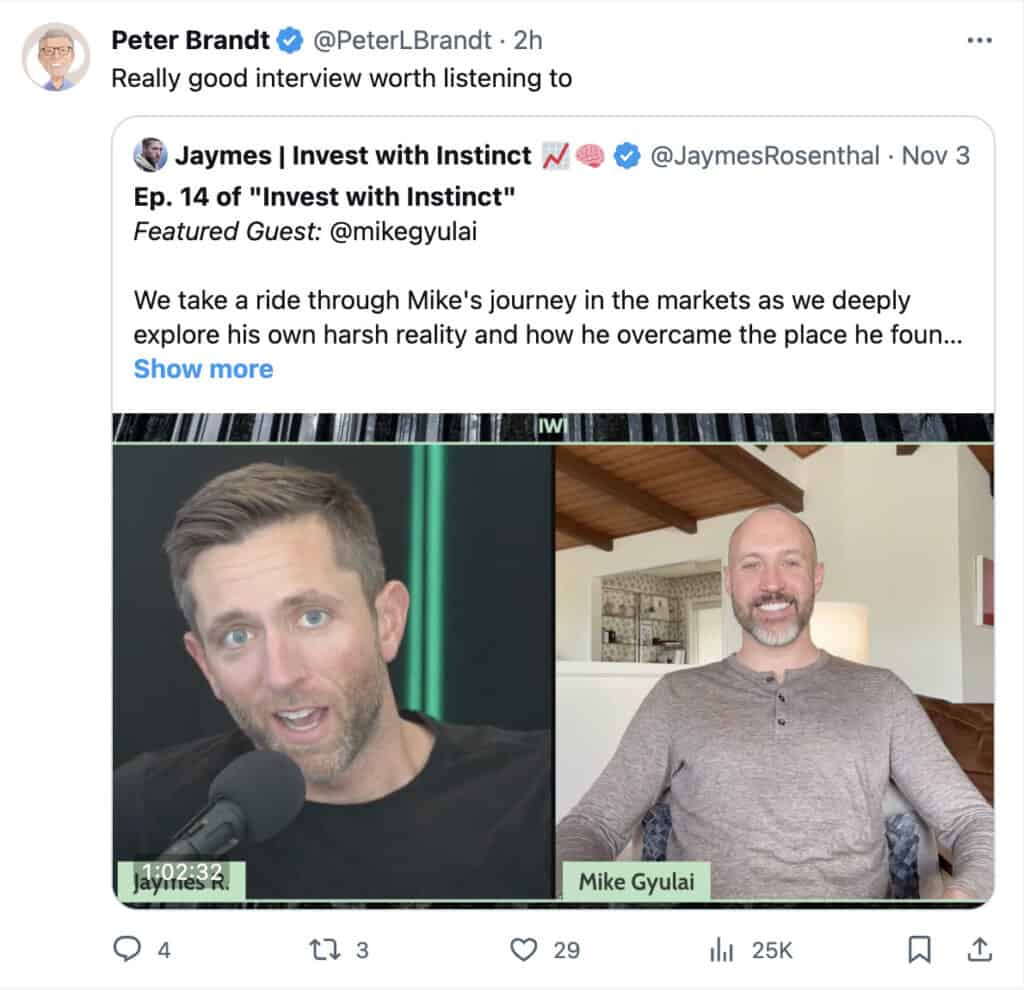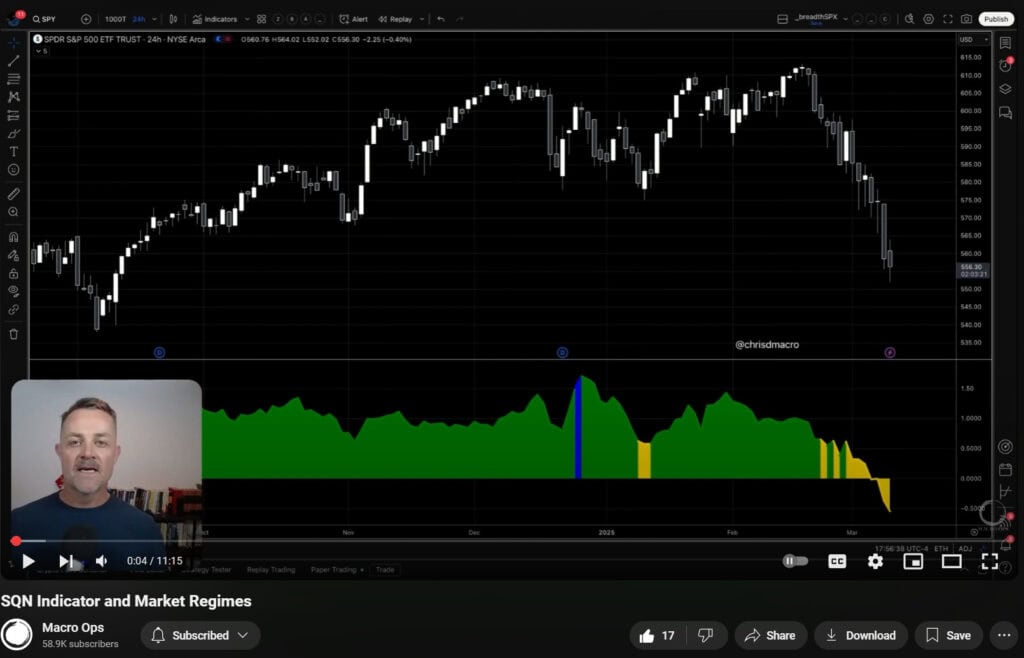Isn’t it great when you spend all day crafting the perfect Twitter thread only to get a few likes and a couple retweets? Yeah, it feels fantastic. Hours spent for nothing.4e
It wasn’t until my conversation with Brian Feroldi that I realized the simple, yet powerful way to grow your Twitter following.
Are you ready for the secret? Grab a pen and paper because here it is: Be worth following
This isn’t an essay on how to “hack” the FinTwit algorithm. Even saying that makes me cringe. Instead we’re highlighting five proven ways (tactics) to increase your FinTwit engagement and following. Five ways to “be worth following”.
It’s not rocket science. But it is hard work. Also, take everything you read with a grain of salt. These are the five tactics that work for me. Things might look different for you.
You ready to learn? Let’s get after it.
Twitter Tactic #1: Develop A Barbell Tweet Strategy
Twitter loves the barbell distribution and you should too. This idea comes from Nassim Taleb’s work on investment portfolio construction. In that aspect, Taleb argued an optimal approach to a portfolio is a collection of risky assets and not-risky assets. Two polar opposites form each side of the barbell.
That same strategy works on Twitter with the length of your tweets.
Users love short, simple tweets that pack a punch. Like a succinct sentence, a short tweet has high virality potential.
That said, tweeters crave longer-form tweet threads. These threads usually explain complex topics or investment ideas in detail. One read-through of the thread and the user has a solid understanding of a topic or company.
Let’s see some examples of each end of the barbell.
Short End: Nintendo (NTDOY)
The more I think about Nintendo $NTDOY, the more I love it. $NTDOY has everything going for it:
– Technicals
– Fundamentals
– Industry tailwinds
Check out this monthly chart below. Perfect breakout above 50MA and 200MA.
We’re long at @MacroOps pic.twitter.com/3p8gS1ufVw
— Brandon Beylo (@marketplunger1) August 22, 2020
Long End: Unity Software S-1 Analysis
[THREAD]
Unity (prop ticker: $U) filed their S-1 this AM.
I read the filing so you don’t have to (but you should).
Here’s a thread on what I found interesting, fascinating and down-right incredible from the company.
I’m starting from zero.
Join me: https://t.co/oYksYkzpb3 pic.twitter.com/QwZMQgrIDZ
— Brandon Beylo (@marketplunger1) August 24, 2020
Takeaway: Mix up the length of your tweets. There’s value in a short blurb with a chart. There’s also value in a long-form breakdown of a company’s business model or valuation. Send a healthy dose of both.
Twitter Tactic #2: Tweet About Specific Companies
One of the most powerful aspects of Financial Twitter (FinTwit) is the ability to track a ticker with the “$” symbol. Use this to your advantage.
Tweet about a company you’re researching or buying. This does a few things. First, it lets you become an expert in that particular company. Using the “$” symbol lets people see how often you’re tweeting and covering that one stock. People then associate you as an expert on that stock.
Second, not only can you carve out a niche for yourself with that company. But you carve out a space for yourself in a given industry. Let’s say you tweet about various cloud computing companies. You use long threads and short blurbs showing different chart set-ups. After a while you become an expert in that area.
Third, it makes people excited when you cover a new name. Remember, tweeting about specific companies and industries makes you the expert (if your work is good). Now when a new company enters your industry, who will people look for analysis? That’s right, you.
Check out this example on Red Violet (RDVT):
$RDVT | Is setting up nicely. Lots to like about this fast-growing small-cap.
“If we assume a 17x exit EBITDA multiple (in line with historical sales), we get $700M in market cap ($62/share). That’s near 3x upside.” via @marketplunger1 https://t.co/xQoaib5EDf pic.twitter.com/tbeH1Jf1lv
— Alex Barrow (@MacroOps) August 7, 2020
Takeaway: Tweet about companies you own and companies you research. Carve your own industry-specific niche.
Twitter Tactic #3: Explain Things Like We’re Fifth Graders
This was something I had to learn the hard way. For the longest time I thought that finding my investing “voice” meant sounding smart. Long and complicated words that nobody uses. Complex analogies and formulas that confuse MIT grad students. I thought these were table stakes in the finance world.
That’s the opposite of how things actually work in this game.
Peter Lynch said it best when he quipped:
“If you’re prepared to invest in a company, then you ought to be able to explain why in simple language that a fifth grader could understand, and quickly enough so the fifth grader won’t get bored.”
The same principle applies to FinTwit. Explain complex subjects and business models in easy-to-understand frameworks. People love that.
It also shows others that you know what you’re talking about. Explaining concepts like unit economics or lifetime value in a democratized way.
This fifth grader concept also acts as a filter for your content production. Learn about something until you can tell a fifth grader about it. When you can do that, make that long thread.
Twitter Tactic #4: Engage With Influencers
Like I said, nothing here is rocket science. Nor is this the first time you’re hearing about them. Our fourth tactic is a perfect example. Engaging with influencers in your niche is a great way to grow your audience. There’s a few ways to do this:
1. Quote retweet an influencers tweet with interesting feedback or thoughts
If you’re trying to grow your audience, never let a retweet go without adding commentary. This shows a deeper level of engagement with the influencer’s content than a mindless retweet. If you can, find a way to mention that user in the quoted retweet. It’ll increase the chances that said influencer will respond.
This also works on influencers you want to troll. Not that you would. But hey! Some people want to watch the world burn. Funny, tongue-in-cheek humor goes a long way if you do it right.
2. Be one of the first to reply to a new tweet
Think of Twitter like a Reddit thread. There’s first-mover advantages. Fire the perfect tweet before anyone else and watch the likes pour in. The earlier you tweet, the sooner people will see your response in the timeline.
Take the shotgun approach to this strategy. You’re not going to nail every response. But like a college freshman looking for a date, it’s a numbers game. Eventually one will work.
3. Curate influencer tweets into a long topical thread
I’ve seen this with David Perrell’s tweets and it’s excellent. You find a collection of tweets from an influencer on a specific topic (i.e., niche). Then you compile those tweets into a long thread with insights along the way.
This creates tremendous value for those that love an influencer’s content. You’ve created a one-stop-shop for someone to learn about a specific topic from that influencer.
And that’s the goal. Be worth following!
Twitter Tactic #5: Aggregate Content & Information
Aggregating content and information is one of the best ways to increase your audience. A perfect example of this tactic in action is Clark Square Capital’s Twitter account.
Clark Square tweets great articles, videos and whitepapers about investing. It’s not “original” content per se, but that doesn’t matter. It’s the curation that matters. I don’t have to search for the content that I would enjoy reading. Clark Square provides it.
Check out some of these examples:
Sean Stannard-Stockton on what defines a high-quality management team: pic.twitter.com/X5p2wb8GyW
— Clark Square Capital (@ClarkSquareCap) August 1, 2020
Securities in an Insecure World – A Lecture by Ben Graham (November, 1963)https://t.co/Nbrg9BBF9Y
— Clark Square Capital (@ClarkSquareCap) July 30, 2020
Here’s a few ideas to get you started on the content aggregation train:
-
- Popular investing YouTube videos
- Valuation methods thread (DCF, EBITDA multiple, asset-based, etc.)
- Interviews from single investor
- Single chart pattern analysis
Conclusion
You’re now equipped with five ways to attack Financial Twitter and grow your audience. These ideas aren’t new. They’re not even that original. But they’re effective. They work.
Try these tactics consistently for a month and check the results. Commit to producing great content. Soon you’ll be what Brian Feroldi calls, “worth following.”







